Guoyang Zhao
Motion-Coupled Mapping Algorithm for Hybrid Rice Canopy
Feb 22, 2025Abstract:This paper presents a motion-coupled mapping algorithm for contour mapping of hybrid rice canopies, specifically designed for Agricultural Unmanned Ground Vehicles (Agri-UGV) navigating complex and unknown rice fields. Precise canopy mapping is essential for Agri-UGVs to plan efficient routes and avoid protected zones. The motion control of Agri-UGVs, tasked with impurity removal and other operations, depends heavily on accurate estimation of rice canopy height and structure. To achieve this, the proposed algorithm integrates real-time RGB-D sensor data with kinematic and inertial measurements, enabling efficient mapping and proprioceptive localization. The algorithm produces grid-based elevation maps that reflect the probabilistic distribution of canopy contours, accounting for motion-induced uncertainties. It is implemented on a high-clearance Agri-UGV platform and tested in various environments, including both controlled and dynamic rice field settings. This approach significantly enhances the mapping accuracy and operational reliability of Agri-UGVs, contributing to more efficient autonomous agricultural operations.
* Best Paper Award First Place - IROS 2024 Workshop on AI and Robotics For Future Farming
Erase, then Redraw: A Novel Data Augmentation Approach for Free Space Detection Using Diffusion Model
Sep 30, 2024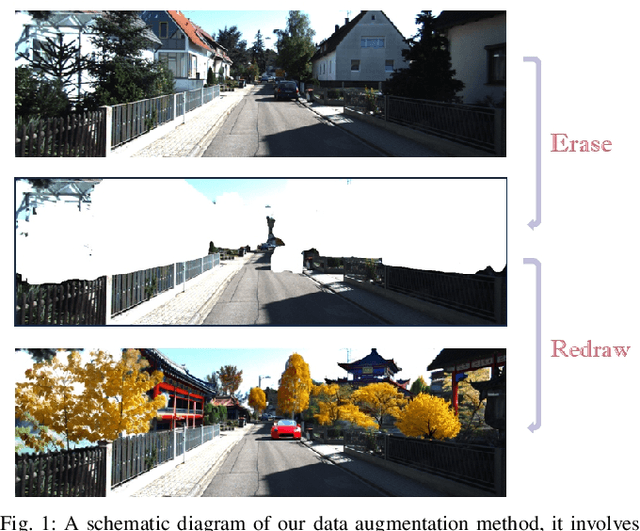
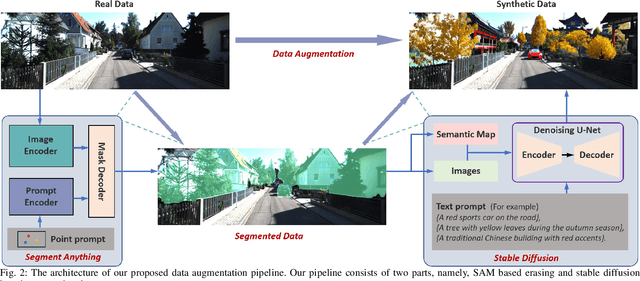
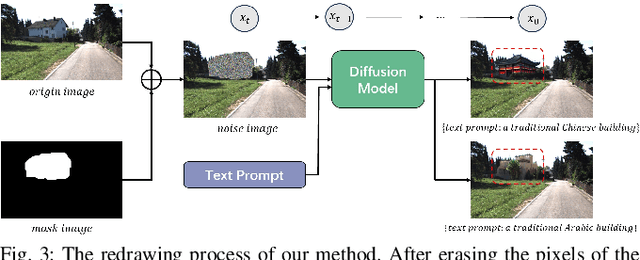
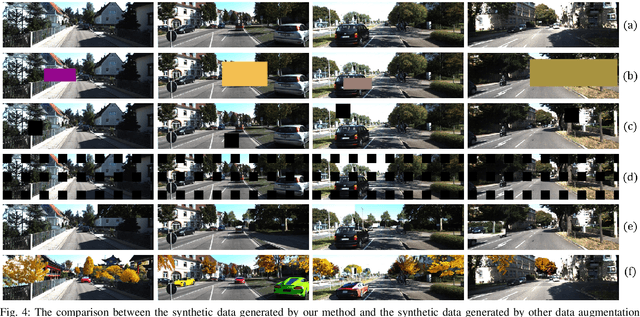
Abstract:Data augmentation is one of the most common tools in deep learning, underpinning many recent advances including tasks such as classification, detection, and semantic segmentation. The standard approach to data augmentation involves simple transformations like rotation and flipping to generate new images. However, these new images often lack diversity along the main semantic dimensions within the data. Traditional data augmentation methods cannot alter high-level semantic attributes such as the presence of vehicles, trees, and buildings in a scene to enhance data diversity. In recent years, the rapid development of generative models has injected new vitality into the field of data augmentation. In this paper, we address the lack of diversity in data augmentation for road detection task by using a pre-trained text-to-image diffusion model to parameterize image-to-image transformations. Our method involves editing images using these diffusion models to change their semantics. In essence, we achieve this goal by erasing instances of real objects from the original dataset and generating new instances with similar semantics in the erased regions using the diffusion model, thereby expanding the original dataset. We evaluate our approach on the KITTI road dataset and achieve the best results compared to other data augmentation methods, which demonstrates the effectiveness of our proposed development.
Task-Oriented Pre-Training for Drivable Area Detection
Sep 30, 2024Abstract:Pre-training techniques play a crucial role in deep learning, enhancing models' performance across a variety of tasks. By initially training on large datasets and subsequently fine-tuning on task-specific data, pre-training provides a solid foundation for models, improving generalization abilities and accelerating convergence rates. This approach has seen significant success in the fields of natural language processing and computer vision. However, traditional pre-training methods necessitate large datasets and substantial computational resources, and they can only learn shared features through prolonged training and struggle to capture deeper, task-specific features. In this paper, we propose a task-oriented pre-training method that begins with generating redundant segmentation proposals using the Segment Anything (SAM) model. We then introduce a Specific Category Enhancement Fine-tuning (SCEF) strategy for fine-tuning the Contrastive Language-Image Pre-training (CLIP) model to select proposals most closely related to the drivable area from those generated by SAM. This approach can generate a lot of coarse training data for pre-training models, which are further fine-tuned using manually annotated data, thereby improving model's performance. Comprehensive experiments conducted on the KITTI road dataset demonstrate that our task-oriented pre-training method achieves an all-around performance improvement compared to models without pre-training. Moreover, our pre-training method not only surpasses traditional pre-training approach but also achieves the best performance compared to state-of-the-art self-training methods.
CLRKDNet: Speeding up Lane Detection with Knowledge Distillation
May 21, 2024Abstract:Road lanes are integral components of the visual perception systems in intelligent vehicles, playing a pivotal role in safe navigation. In lane detection tasks, balancing accuracy with real-time performance is essential, yet existing methods often sacrifice one for the other. To address this trade-off, we introduce CLRKDNet, a streamlined model that balances detection accuracy with real-time performance. The state-of-the-art model CLRNet has demonstrated exceptional performance across various datasets, yet its computational overhead is substantial due to its Feature Pyramid Network (FPN) and muti-layer detection head architecture. Our method simplifies both the FPN structure and detection heads, redesigning them to incorporate a novel teacher-student distillation process alongside a newly introduced series of distillation losses. This combination reduces inference time by up to 60% while maintaining detection accuracy comparable to CLRNet. This strategic balance of accuracy and speed makes CLRKDNet a viable solution for real-time lane detection tasks in autonomous driving applications.
Monocular 3D lane detection for Autonomous Driving: Recent Achievements, Challenges, and Outlooks
Apr 10, 2024Abstract:3D lane detection plays a crucial role in autonomous driving by extracting structural and traffic information from the road in 3D space to assist the self-driving car in rational, safe, and comfortable path planning and motion control. Due to the consideration of sensor costs and the advantages of visual data in color information, in practical applications, 3D lane detection based on monocular vision is one of the important research directions in the field of autonomous driving, which has attracted more and more attention in both industry and academia. Unfortunately, recent progress in visual perception seems insufficient to develop completely reliable 3D lane detection algorithms, which also hinders the development of vision-based fully autonomous self-driving cars, i.e., achieving level 5 autonomous driving, driving like human-controlled cars. This is one of the conclusions drawn from this review paper: there is still a lot of room for improvement and significant improvements are still needed in the 3D lane detection algorithm for autonomous driving cars using visual sensors. Motivated by this, this review defines, analyzes, and reviews the current achievements in the field of 3D lane detection research, and the vast majority of the current progress relies heavily on computationally complex deep learning models. In addition, this review covers the 3D lane detection pipeline, investigates the performance of state-of-the-art algorithms, analyzes the time complexity of cutting-edge modeling choices, and highlights the main achievements and limitations of current research efforts. The survey also includes a comprehensive discussion of available 3D lane detection datasets and the challenges that researchers have faced but have not yet resolved. Finally, our work outlines future research directions and welcomes researchers and practitioners to enter this exciting field.
OmniColor: A Global Camera Pose Optimization Approach of LiDAR-360Camera Fusion for Colorizing Point Clouds
Apr 06, 2024



Abstract:A Colored point cloud, as a simple and efficient 3D representation, has many advantages in various fields, including robotic navigation and scene reconstruction. This representation is now commonly used in 3D reconstruction tasks relying on cameras and LiDARs. However, fusing data from these two types of sensors is poorly performed in many existing frameworks, leading to unsatisfactory mapping results, mainly due to inaccurate camera poses. This paper presents OmniColor, a novel and efficient algorithm to colorize point clouds using an independent 360-degree camera. Given a LiDAR-based point cloud and a sequence of panorama images with initial coarse camera poses, our objective is to jointly optimize the poses of all frames for mapping images onto geometric reconstructions. Our pipeline works in an off-the-shelf manner that does not require any feature extraction or matching process. Instead, we find optimal poses by directly maximizing the photometric consistency of LiDAR maps. In experiments, we show that our method can overcome the severe visual distortion of omnidirectional images and greatly benefit from the wide field of view (FOV) of 360-degree cameras to reconstruct various scenarios with accuracy and stability. The code will be released at https://github.com/liubonan123/OmniColor/.
CurbNet: Curb Detection Framework Based on LiDAR Point Cloud Segmentation
Mar 25, 2024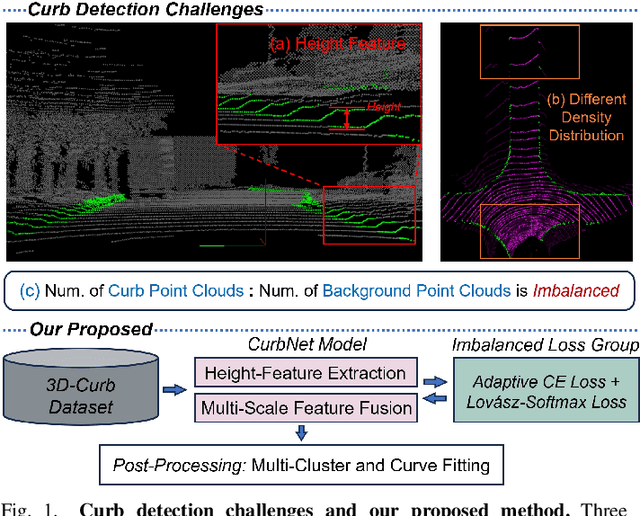
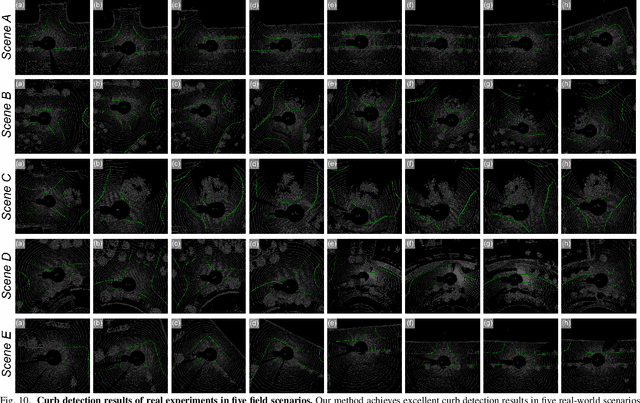
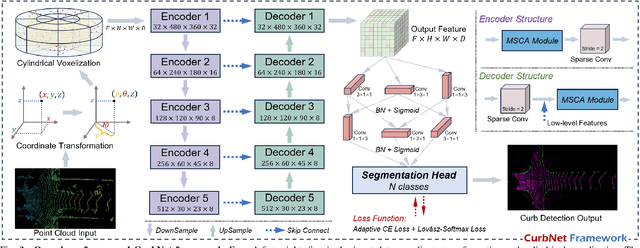
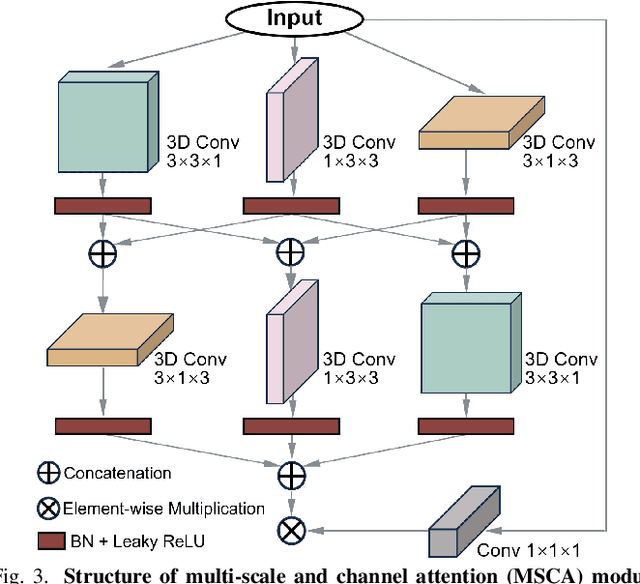
Abstract:Curb detection is an important function in intelligent driving and can be used to determine drivable areas of the road. However, curbs are difficult to detect due to the complex road environment. This paper introduces CurbNet, a novel framework for curb detection, leveraging point cloud segmentation. Addressing the dearth of comprehensive curb datasets and the absence of 3D annotations, we have developed the 3D-Curb dataset, encompassing 7,100 frames, which represents the largest and most categorically diverse collection of curb point clouds currently available. Recognizing that curbs are primarily characterized by height variations, our approach harnesses spatially-rich 3D point clouds for training. To tackle the challenges presented by the uneven distribution of curb features on the xy-plane and their reliance on z-axis high-frequency features, we introduce the multi-scale and channel attention (MSCA) module, a bespoke solution designed to optimize detection performance. Moreover, we propose an adaptive weighted loss function group, specifically formulated to counteract the imbalance in the distribution of curb point clouds relative to other categories. Our extensive experimentation on 2 major datasets has yielded results that surpass existing benchmarks set by leading curb detection and point cloud segmentation models. By integrating multi-clustering and curve fitting techniques in our post-processing stage, we have substantially reduced noise in curb detection, thereby enhancing precision to 0.8744. Notably, CurbNet has achieved an exceptional average metrics of over 0.95 at a tolerance of just 0.15m, thereby establishing a new benchmark. Furthermore, corroborative real-world experiments and dataset analyzes mutually validate each other, solidifying CurbNet's superior detection proficiency and its robust generalizability.
Test-Time Adaptation for Nighttime Color-Thermal Semantic Segmentation
Jul 10, 2023Abstract:The ability to scene understanding in adverse visual conditions, e.g., nighttime, has sparked active research for RGB-Thermal (RGB-T) semantic segmentation. However, it is essentially hampered by two critical problems: 1) the day-night gap of RGB images is larger than that of thermal images, and 2) the class-wise performance of RGB images at night is not consistently higher or lower than that of thermal images. we propose the first test-time adaptation (TTA) framework, dubbed Night-TTA, to address the problems for nighttime RGBT semantic segmentation without access to the source (daytime) data during adaptation. Our method enjoys three key technical parts. Firstly, as one modality (e.g., RGB) suffers from a larger domain gap than that of the other (e.g., thermal), Imaging Heterogeneity Refinement (IHR) employs an interaction branch on the basis of RGB and thermal branches to prevent cross-modal discrepancy and performance degradation. Then, Class Aware Refinement (CAR) is introduced to obtain reliable ensemble logits based on pixel-level distribution aggregation of the three branches. In addition, we also design a specific learning scheme for our TTA framework, which enables the ensemble logits and three student logits to collaboratively learn to improve the quality of predictions during the testing phase of our Night TTA. Extensive experiments show that our method achieves state-of-the-art (SoTA) performance with a 13.07% boost in mIoU.
 Add to Chrome
Add to Chrome Add to Firefox
Add to Firefox Add to Edge
Add to Edge